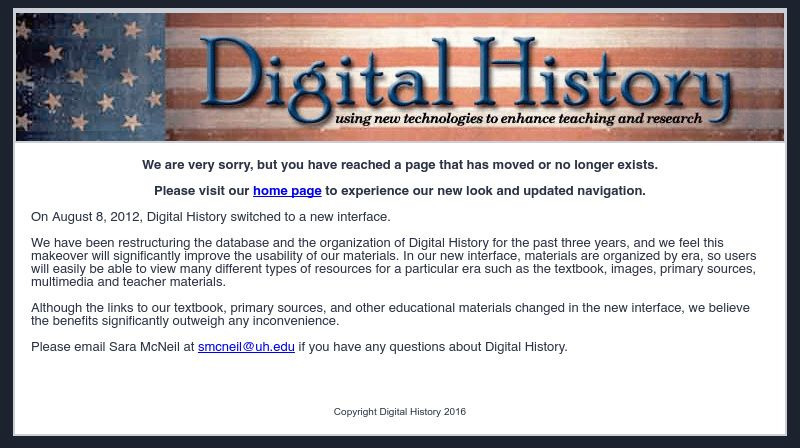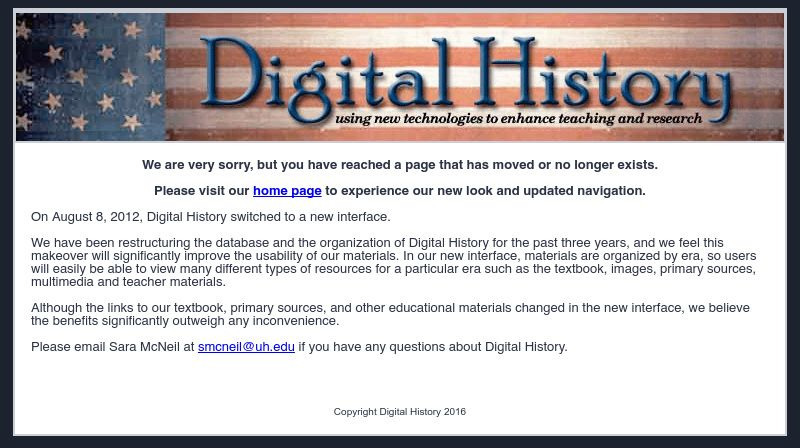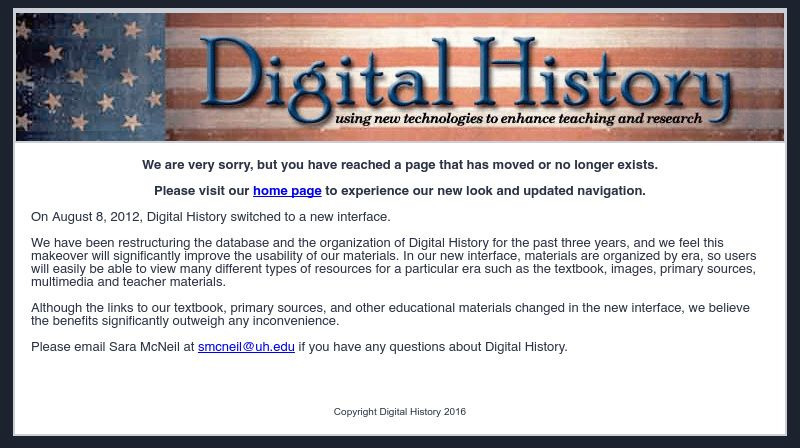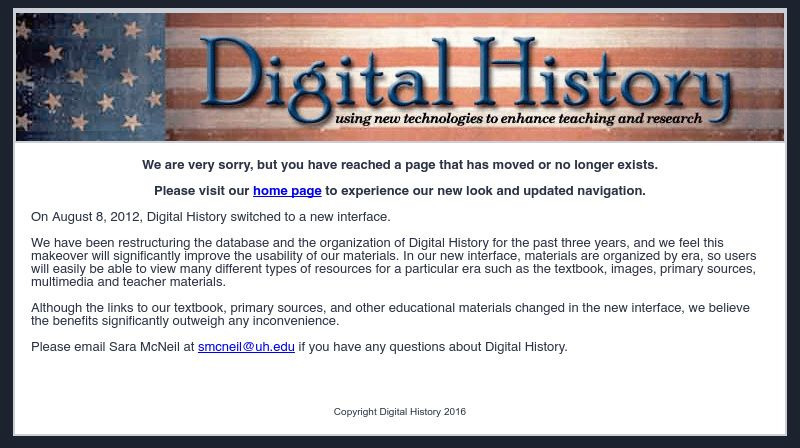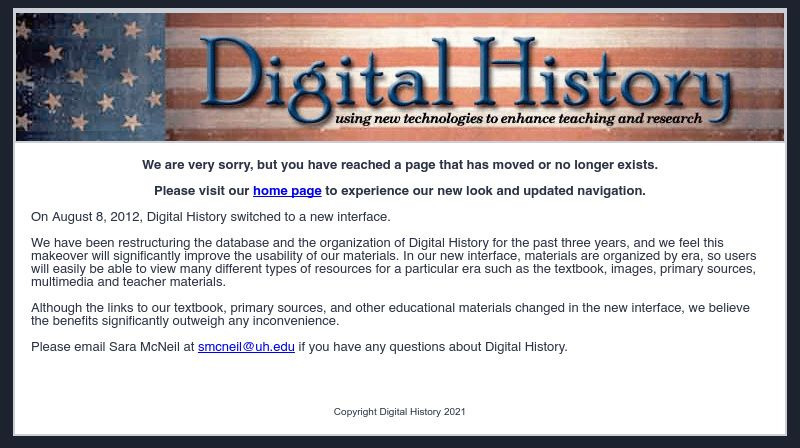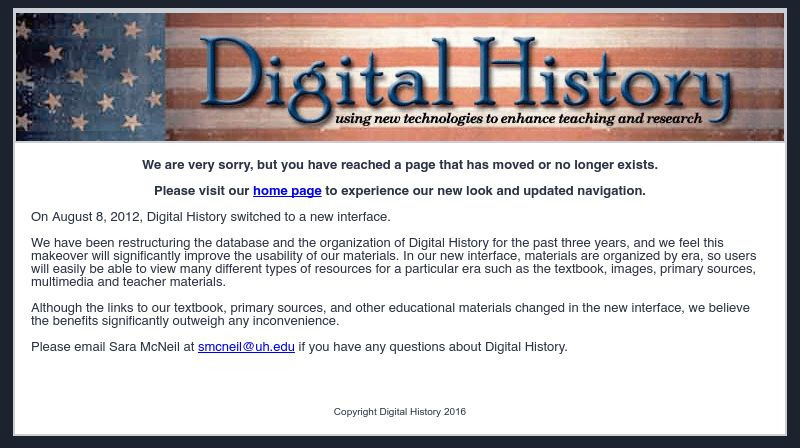Digital History
Digital History: The Crisis of 1850
A preview of will prompt the passage of the Compromise of 1850. Read about California's bid for statehood as a free state.
Digital History
Digital History: The Revival of the Slavery Issue
A brief account of how the Kansas-Nebraska Act split apart party coalitions and helped create the new Republican Party. See who joined this party and read about its goals.
Digital History
Digital History: The Election of 1856
A brief account of the election of 1856, the first in which the new Republican Party put forth a presidential candidate. See how the election split down regional lines.
Digital History
Digital History: The Gathering Storm
A look at how the Northerners perceived the conflict between North and South, a conflict between people who were for freedom and and those who were for slavery.
Digital History
Digital History: The Atlantic Slave Trade
A brief but sobering look at the slave trade and the number of slaves in the New World in the 16th, 17th, and early 17th centuries. Slaves could be found from Nova Scotia to Argentina.
Digital History
Digital History: Toward Slavery
A brief description of the course toward making African slaves chattel property, which greatly restricted any hints of personal freedom.
Digital History
Digital History: Antebellum Slavery
The ideals of liberty after the Revolutionary War brought freedom to many slaves. Read about why the institution of slavery rebounded after the introduction of the cotton gin.
Digital History
Digital History: Introduction: Tecumseh and the Shawnee Prophet
Discussion of the breakdown in Indian society in the late 18th century focusing on famed Shawnee war chief Tecumseh.
Digital History
Digital History: Social Security
A brief look at the Social Security Act of 1935 which expanded the government's role in providing social welfare to those in need. See whom the Act did not help and read about how the legislation exanded the Americans' view of what...
Digital History
Digital History: The Dispossessed
A brief look at those most affected by the unemployment crisis during the Great Depression. Read about the unemployment of African-Americans, and the deportation of Mexican-Americans.
Digital History
Digital History: The Market Crashes
Read about how in just five days a shaky stock market crashed and helped plunge the country into the Great Depression.
Digital History
Digital History: America at War: World War I: Sgt. York
A brief biography of Sgt. Alvin York, one of the most famous infantrymen fighing in the American Expeditionary Force in World War I.
Digital History
Digital History: America at War: The Lusitania
A brief description of the sinking of the Lusitania and why that occurance eventurally broke down American neutrality, and the United States finally entered World War I.
Digital History
Digital History: America at War: The United States Enters the War
A look at American neutrality at the start of World War I, its favoring of the allies, and the reasons the United States entered the war in 1917.
Digital History
Digital History: The 1920s an Overview
A brief overview of what is in store for America in the 1920s, the Jazz Age. Read about the rise of consumerism, the clash of values, and the rise of fearing the "other."
Digital History
Digital History: Immigration Restriction
A brief discussion about the views toward immigration before and after World War I. It gives the background of the Immigration Act of 1924.
Digital History
Digital History: The Democratic Convention of 1924
The representatives to the Democratic Convention in 1924 were diverse and devisive. Read about how groups holding totally opposite beliefs attempted to select a candidate to run against Calvin Coolidge. Read about the results of the...
Digital History
Digital History: Low Brow and Middle Brow Culture
A good overview of the popular culture in the Jazz Age. Read about the kinds of entertainment and literature enjoyed by the middle class in the 1920s.
Digital History
Digital History: The Critical Period: Introduction
The years immediately following the end of the Revolutionary War were fraught with problems both domestically and in foreign affairs. There were also accomplishments in the expansion of the economy. Read about the problems and why...
Digital History
Digital History: The Threat of a Military Coup
A brief discussion of the Newburgh Conspiracy, a threat for soldiers to take over the government because of the Confederation Congress' failure to pay them.
Digital History
Digital History: The Tyranny of the Majority
See how the actions of state legislatures threatened the very existence of a national government during the Confederation Era.
Digital History
Digital History: What Americans Don't Know About the Constitution
Read about the woeful lack of understanding Americans have of their own guding document, the Constitution.
Digital History
Digital History: The Oldest Written National Framework of Government
See how unique the U.S. Constitution has been over the 200 plus years of our government.
Digital History
Digital History: Was the Constitutional Convention Legal?
A look at the convening of a Constitutional Convention to address the problems inherent in the Articles of Confederation. Read a quote from George Washington, who addressed the legality of such a convention.







